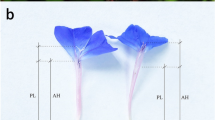Abstract
The aim of the present investigation is to compare two geographically well separated populations ofC. afra with different mating systems with emphasis on (1) factors controlling the length of the male phase with special attention paid on the pollen collecting hairs, (2) crossing ability among populations with different mating systems; shouldC. afra be regarded as one or several species?, and (3) correlations between pollen germinability and mating system; how does pollen germinability vary with anthesis and stigma development? From the results it can be concluded that the length of the male phase and the development of the stigma depend on the stimulation of the pollen collecting hairs rather than on the amount of pollen removed. Furthermore, the length of the male phase was found to be correlated with the mating system, i.e., in the population with a mixed mating system, the differences between treated and untreated flowers were less pronounced than in the population being obligately outcrossing. I also found correlations between mating system and pollen germinability, where the population with a mixed mating system had a high germinability at stigma receptivity, whereas for the xenogamous population, the germinability approached zero at stigma development. No crossing incompatibility was found between the two populations ofCampanula afra in any of the combinations.
Similar content being viewed by others
References
Brogniart, A., 1839: Note sur poils collecteurs des Campanules et sur le mode de fécondation de ces plantes. — Ann. Sci. Nat., ser. 2,12: 244–247.
Cassini, H., 1818: Sur une anomalie remarquable du mode de fécondation dans la Campanule a feuilles rondes. — Bull. Sci. Soc. Philomat: 106–107. — Paris.
Dahl, Å., 1989: Taxonomic and morphological studies inHypecoum sect.Hypecoum (Papaveraceae). — Pl. Syst. Evol.163: 227–280.
Devlin, B., Stephenson, A. G., 1984: Factors that influence the duration of the staminate and pistillate phases ofLobelia cardinalis flowers. — Bot. Gaz.145: 323–328.
Hartig, T., 1842: Neue Theorie der Befruchtung der Pflanzen. — Braunschweig.
Hassall, A. H., 1842: Observations on the functions performed by the hairs on the stigma inCampanulaceae, Compositae, and other plants. — Ann. Mag. Nat. Hist.8: 84–87.
Lloyd, D. G., Yates, J. M. A., 1982: Intrasexual selection and the segregation of pollen by stigmas in hermaphroditic plants, exemplified byWahlenbergia albomarginata (Campanulaceae). — Evolution36: 903–913.
—,Webb, C. J., 1986: The avoidance of interference between the presentation of pollen and stigmas in angiosperms. I. Dichogamy. — New Zealand J. Bot.24: 135–162.
Meyen, F. J. F., 1839: Neues System der Pflanzenphysiologie. 3, p. 248.
Molau, U., 1988:Scrophulariaceae. Part I.Calceolarieae. — Flora Neotropica, Monograph47: 1–326.
Nyman, Y., 1991: Crossing experiments within theCampanula dichotoma group (Campanulaceae). — Pl. Syst. Evol.177: 185–192.
—, 1992: Factors influencing pollen germination in sixCampanula species (Campanulaceae). — Pl. Syst. Evol.181: 97–108.
Oschwald, M., 1919: Observations sur la biologie florale des campanules. — Bull. Soc. Bot. Geneve11: 64–69.
Richardson, T. E., Stephenson, A. G., 1989: Pollen removal and pollen deposition affect the duration of the staminate and pistillate phases inCampanula rapunculoides. — Amer. J. Bot.76: 532–538.
Shetler, S. G., 1979: Pollen-collecting hairs ofCampanula (Campanulaceae). I. Historical review. — Taxon28: 205–215.
Sprengel, C. K., 1793: Das entdeckte Geheimnis der Natur im Bau und in der Befruchtung der Blumen. — Berlin.
Strandhede, S.-O., 1966: Morphologic variation and taxonomy in EuropeanEleocharis, subser.Palustres. — Opera Bot.10: 1–187.
Webb, C. J., Lloyd, D. G., 1986: The avoidance of interference between the presentation of pollen and stigmas in angiosperms. II. Herkogamy. — New Zealand J. Bot.24: 163–178.
Wilson, W., 1842: On the hair-collectors ofCampanula, and the mode of its fecundation. — London J. Bot.1: 601–605.
—, 1847: Note on DrHartig's new theory of the fertilization of plants. — The Phytologist2: 965–966.
—, 1848: Further remarks on the pollen-collectors ofCampanula, and on the mode of fecundation. — London J. Bot.7: 92–97.
Wyatt, R., 1984: The evolution of self-pollination in granite outcrop species ofArenaria (Caryophyllaceae). I. Morphological correlates. — Evolution38: 804–816.
Author information
Authors and Affiliations
Rights and permissions
About this article
Cite this article
Nyman, Y. Reproduction inCampanula afra (Campanulaceae): Mating system and the role of the pollen collecting hairs. Pl Syst Evol 183, 33–41 (1992). https://doi.org/10.1007/BF00937733
Received:
Revised:
Accepted:
Issue Date:
DOI: https://doi.org/10.1007/BF00937733




